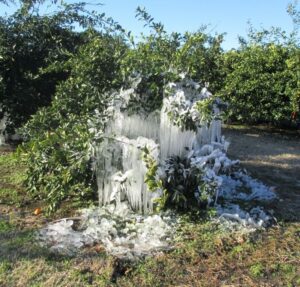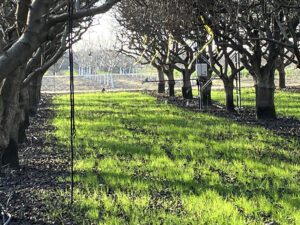
Early frosts, late frosts, long heat waves and warm, dry or wet winters can have adverse impacts on production agriculture. There is no denying that increasingly variable weather from year to year and increased frequency and severity of extreme weather events are occurring. These weather events often result in significant and multiple impacts on production agriculture in California. Plant health, crop yields and quality are affected, making it difficult to achieve and sustain production and profitability targets.
In an interview with Daniele Zaccaria, UC Davis associate professor and UCCE specialist in agriculture water management, and Tapan Pathak, UCCE specialist in climate adaptation in agriculture at UC Merced, they outlined the top five key effects of climate change on agriculture and presented mitigation strategies for growers. They noted development of models for disease outbreaks; integrated pest management practices; improved medium- to long-range weather forecasting; and development of varieties and rootstocks that are tolerant of weather extremes and to adverse growing conditions (i.e., water supply limitations, degraded irrigation water quality, salinity buildup) are adaptation strategies growers can implement to preserve crop production.

1. Heightened Temps and Inadequate Chill
Pathak said one of the most significant climate change impacts on agriculture would be heightened minimum temperatures during the winter. Zaccaria explained lack of cold temperatures during the dormant period for tree nuts causes uneven flowering and budbreak. This affects pistachio production, particularly in the southern growing regions, and has a negative effect on walnut and cherry production. Inadequate chill accumulation causes the non-synchronous flowering of male and female pistachio trees, and may lead to reduced fruit set and variable nut yield and maturity at harvest time.
Along with warmer winters, prolonged summer heat waves impact production and crop quality. Pathak said longer heat waves are expected to occur. The San Joaquin Valley region typically experiences extreme heat, more than 103 degrees F for short periods. In the future, Pathak said, there could be 40 to 50 days per year of high temperatures, which would impact crop growth and production yield and quality. An example is the severe heat wave in late summer 2022 which caused significant quality damage in walnut. On the other extreme, frosts that hit during bloom can adversely impact yields. Pathak said frosts earlier in the fall or later in the spring pose a risk to crops.
“We are in the transition phase right now; there is less risk of frost with warmer temperatures, but the risk of late frost remains,” he said.

2. Increased Frequency of Climate Extremes
California agriculture is highly sensitive to increased frequency and intensity of climate extremes. Pathak and Zaccaria wrote in a paper published in Agronomy that tree nuts, a permanent crop that is in the ground for more than 25 years, are more vulnerable to impacts of climate change. They noted while California growers have always been affected by the natural variability of weather from year to year, the increased rate and scale of climate change is beyond the realm of experience of the agricultural community.
3. Changing Pest and Disease Trends
Insect pests and diseases can be influenced by changes in temperature and precipitation. Warmer temperatures may allow more generations of insect pests during the growing season and migration to areas where colder temperatures previously limited their activity. Warmer temperatures are expected to create conditions conducive to the spread of fungal diseases. Pathak said for pests, including navel orangeworm (NOW), codling moth and peach twig borer, there is evidence of earlier biofix.
His study showed a strong statistically significant downward trend across most California tree nut producing counties in the time it takes for NOW to complete their generations over time. This indicates the life cycle of NOW can be shortened by nearly six weeks. NOW body temperature is regulated by the ambient temperature, which has an impact on how soon they complete their generations. Counties in the southern part of the San Joaquin Valley have already seen a fifth generation, Pathak said, and in the coming years, that can happen in counties farther north.
‘’With more generations, the population increases exponentially with big impact on tree nuts,” he said.

4. Changing Rainfall Patterns
Changes in rainfall patterns combined with increased evaporation due to higher temperatures and drier air are predicted to lead to water scarcity or limitations in many growing regions. Shifts in water availability can impact operations of irrigation infrastructures. Pathak said globally, climate change affects precipitation in two ways: strengthening the existing precipitation patterns and by moving storms away from the equator toward the poles as atmospheric circulation changes. Climate change simulations suggest California will maintain its Mediterranean climate, but trends indicate higher annual rainfall amounts in the north while the southern part of the state is expected to be 15% to 35% drier by 2100. Snowpack critical to generate water supply for meeting crop water needs is expected to melt earlier during warmer winters and in the spring.
5. Impacts to Productivity
The cumulative effect of changes in climate will impact productivity. Reduced yields due to higher or lower temperatures along with uncertain water supplies can affect availability of California-grown produce. Pathak noted due to the diversity of the state’s agriculture industry, each crop will respond to climate differently. Adaptation research, he added, should be locally focused and include stakeholder engagement and outreach efforts.
Adaptation Strategies
Agriculture adaptation strategies to mitigate adverse effects on crop production will be necessary, both researchers agreed. Development of climate resilient varieties and rootstocks, improved weather-adaptive water management and improved weather forecasting systems to anticipate extreme weather events are some of the mitigation measures to preserve production.
Pathak said more accurate forecasting of winter chill accumulation will help growers of affected crops. Field data and modeling can help with mitigation efforts. Accurate modeling two weeks out and beyond on the magnitude and duration of weather events is critical, Zaccaria said. Accurate medium- to long-range forecasts will allow growers to prepare and plan for implementing mitigation strategies. Planting cover crops ahead of time is an example as they can help with improving soil infiltration and prevent ponding, which may allow orchard access after heavy rain and flooding events.
Pathak said the online decision support tool CalAgroClimate, sponsored by UC Davis, UC Merced and USDA, is available to growers. Tools include a heat advisory, frost advisory, degree day calculator, pest advisory and agroclimatic indicators.
Zaccaria and Pathak will be speaking at three climate-smart agricultural production workshops in March 2024. The first is scheduled for March 7 in Tulare, Calif. at the International Agri-Center and will focus on climate-smart ag practices for fruit and nut production. Two other workshops will be held during the second week of March 2024 in Ventura, Calif. with focuses on citrus, avocado, vegetables and berries, and in Salinas, Calif. with focuses on vegetables, berries and grapevine.

Cecilia Parsons | Associate Editor
Cecilia Parsons has lived in the Central Valley community of Ducor since 1976, covering agriculture for numerous agricultural publications over the years. She has found and nurtured many wonderful and helpful contacts in the ag community, including the UCCE advisors, allowing for news coverage that focuses on the basics of food production.
She is always on the search for new ag topics that can help growers and processors in the San Joaquin Valley improve their bottom line.
In her free time, Cecilia rides her horse, Holly in ranch versatility shows and raises registered Shetland sheep which she exhibits at county and state fairs during the summer.














